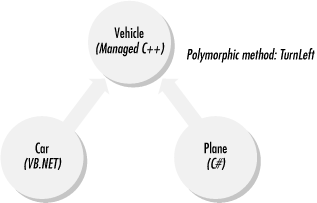Language Integration
In the previous section, we saw that you can take advantage of .NET object-oriented concepts in any .NET language. In this section, we show that you can take advantage of language integration—the ability to derive a class from a base that is specified in a totally different language, or to catch exceptions thrown by code written in a different language, or to take advantage of polymorphism across different languages, and so forth.
Before we discuss the examples in this section, let’s first understand what we want to accomplish (see Figure 3-1). We will first use Managed C++ to develop a Vehicle class that is an abstract base class. The Vehicle class exposes three polymorphic methods, including TurnLeft( ), TurnRight( ), and ApplyBrakes( ). We will then use VB.NET to develop a Car class that derives from Vehicle and overrides these three virtual methods. In addition, we will use C# to develop the Plane class that derives from Vehicle and overrides these three virtual methods.

Figure 3-1. Polymorphism across languages
In the upcoming code example, we can tell a Vehicle to TurnLeft( ) or TurnRight( ), but what turns left or right depends upon the target object, whether a Car or a Plane. Unlike the examples in the last section, the examples here illustrate that we can inherit classes and call virtual functions from ones that are defined in another language. In addition, ...
Get .Net Framework Essentials now with the O’Reilly learning platform.
O’Reilly members experience books, live events, courses curated by job role, and more from O’Reilly and nearly 200 top publishers.

